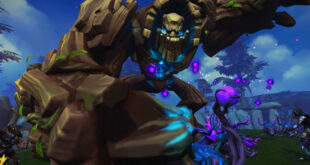Device 6 is one of the most unique gaming experiences you can find on the App Store, and you can say the same about pretty much every other game Simogo has made, from Bumpy Road to Beat Sneak Bandit to Year Walk.
Magnus Gardebck – or Gordon, as he is commonly known – is one half of the Swedish indie studio (the other being Simon Flesser) that has, with its last two games, become something of a poster child for unconventional storytelling in games. Gordon was in India recently for the NASSCOM Game Developer Conference, and we had a chance to chat about Simogo’s approach to game development, its success on the App Store, going back to consoles, and his impressions of the game development talent in India.
Read closely enough and there’s also a faint hint to what Simogo has in store for us next.
You’ve mentioned in the past that you guys don’t have a fixed method in place for the development process. You still somehow manage complete your games within six months or so. How do you manage that?
We’re pretty efficient in the way we work. Although we self-publish everything, we always discuss early on in the project how big of a scope we would like and how many months that would take. That has turned out to be spot-on for us for all our projects, except Year Walk. That took about 10 months on that and it was tough in the last two months.
Do you feel many of the development processes that have become the norm in the industry get in the way of creativity?
Not really. For example, design documents make sense if you’re a bigger team to keep everything aligned with the vision, and everyone can read up on the design. But for us, being just two people, it doesn’t really make sense. We just bounce ideas back and forth and discuss these things.
So do you often find yourselves changing core elements of a game as you go through the development process?
Sure. In Beat Sneak Bandit, for example, we struggled with the gameplay mechanics for at least two months before we came up with the one-touch input mechanic. Also, if we spot something we don’t like, we change it. In Year Walk, we actually changed stuff in the last week of development. In general, we always keep an open mind about the design so that we don’t constrain ourselves in the early stages of projects.
In your talk at NASSCOM GDC, you mentioned that all your games, except for the first one – Kosmo Spin, have been featured on the App Store. You now have the name and you have the fanbase, but did you have a game plan in place for how you would market and promote your games if they weren’t featured?
We always have a strategy in place – the usual stuff like putting out trailers three or four months ahead to get the word out, and building some hype from there. In that respect, Kosmo Spin was the hardest one, because no one knew about Simogo. It was the same with Bumpy Road as well, but when Apple picked it up, they loved it. It made things very easy for us after that. Then Beat Sneak Bandit won the IGF award, and after that the whole scene changed because we started getting a lot of media coverage. But we still continue to do PR, we send out emails and stuff like that.
Device 6
Does PR or getting media coverage help anywhere near as much as being featured on the App Store?
Getting featured helps a lot more, because visibility in the App Store is everything. If your game isn’t visible, you don’t exist. So getting that banner is huge.
You mentioned that you chose the iOS platform over Android because the devices and screen sizes were fewer. Have you considered working on any other platforms beyond mobile?
We actually released Bumpy Road for PC and Mac as well, but it’s obviously is a touch game, so it didn’t work out as well. We don’t like to just port our games to other platforms. If we were to release on other platforms, we would reinvent some of the processes and inputs to fit those platforms. People recognise when developers just port their iOS games to PC, so we’d want to do something that feels right on the new platform.
You’ve created very unique and original games and they’ve all been very different from each other. Do you ever think about going back to one of your previous games and expanding on those ideas?
Out first three games were all sort of similar in that they all had the same cute, artsy feel to them, and then Year Walk and Device 6 are more story-based games. Maybe our sixth game will be somewhat similar to Year Walk and Device 6, but we’ll probably want to go back to our early style at some point.
You’ve worked quite a bit on console games during your time at Southpeak. With so much focus on indie games and developers with the new consoles, do you ever consider going back to those platforms, may be for a game that would work better with a controller?
Yes, we could actually do some pretty cool stuff with those controls. We discuss it all the time, but we’re a two-man team, so the biggest struggle in going back to consoles again is the certification process, which takes two-three months. So we started Simogo so we can make smaller-scope games.
Is the long-term plan to continue Simogo as just yourself and Simon, or do you plan to expand the team?
We discussed that when we started Simogo. Our vision has been the same – to not have Simogo bigger than four or five people. We haven’t hired anyone yet, but we use freelance musicians and story writers. So it’s like two plus two.
This being your first time in India, what are your impressions of the game development talent here based on what you saw at NGDC?
There are some very talented developers here. The industry seems very tight; everyone knows each other. I only had a chance to see the games from the BYOG competition, and there were some good games in there.
Year Walk
Device 6 is out now and it’s doing really well. Do you tend to iterate and update your games once you’ve released them or do you just jump right into the next game?
We move onto the next project. The only game we’ve done an update for was Bumpy Road, but only because we were so excited about that new feature that we decided to extend the game.
For a few of your games, you’ve created in-game level editors to help with the level creation process. Have you ever considered including level editors to enable user-generated content within your games?
Yes, we actually discussed that. The editors that we have would require more user interface design, but it should work. They would have to be customised quite a bit as well. Being such small-scope projects, they’re kind of brute force editors, so we know what to do with them, but they’re not very user-friendly. But yes, we discussed that quite a bit, especially for Beat Sneak Bandit, but we never went through with it.
You’ve mentioned that you’re happy with the premium revenue model and you’re not looking to go free-to-play. You create very unique and original games that are regularly featured, but do you think premium is a viable solution for all developers?
Pricing is one of the most difficult decisions and there is no right and wrong. We usually start discussing two months before a game’s release where we’re going to place it price range-wise. It’s a difficult decision. On the App Store, there was a time when everything had to be 99 cents, but I think we’re beyond that now. We can sell games that are premium priced, and niche games now sell really well. So we’re really happy that we can make a living out of this.
Do you know what game you’re going to make next or are you still thinking about it?
We’re somewhere in between. This is actually the first time that we’re winding down a bit to recharge the batteries, so to speak. We have something going on, but we can’t talk about it yet. But it’s nice to take things slow for a while.
Sign up for the free MCV India newsletterhere.

 MCV/DEVELOP News, events, research and jobs from the games industry
MCV/DEVELOP News, events, research and jobs from the games industry



